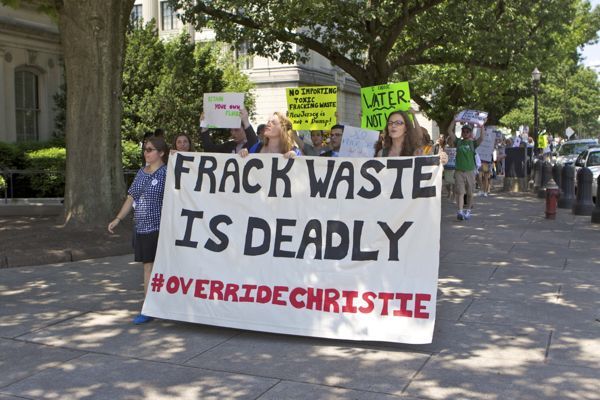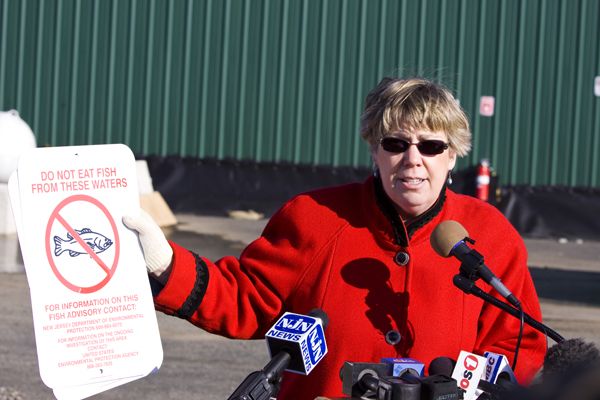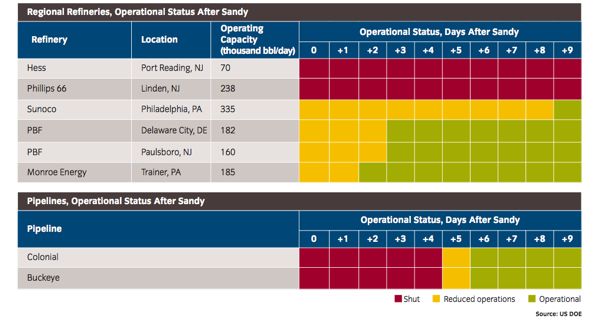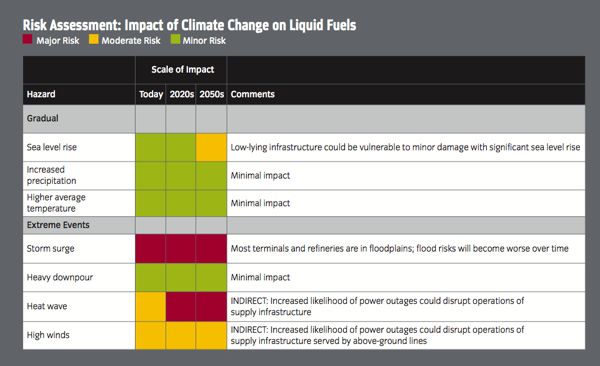Debate Over RGGI A Diversion
10 Years After DEP First Regulated CO2, No Followup
Grassroots Movement Politics, Direct Regulation, Real Price on Carbon Are Solutions
“Cap and trade with offsets would guarantee that we pass climate tipping points, locking in climate disasters for our children. Cap and trade benefits only Wall Street and polluters, sacrificing humanity and nature for their profits.” Dr. James Hansen ~~~ 11/30/09

Fracktivists march on Trenton Capitol (6/20/13)
Quite a bit has been written about how the big national beltway environmental organizations made a major blunder in putting all their campaign eggs in the failed insider strategy to have Congress pass so called climate change “cap and trade” legislation, e.g. see: this major academic Report and Washington Post story “Why has climate change legislation failed” for the mainstream assessment.
For a harsher and more controversial critique, with which I strongly agree, see Naomi Klein’s interview in Salon: Green groups may be more damaging than climate change deniers (she exempts Sierra, Greenpeace, Friends of the Earth, and 350.org from this withering assessment):
Well, I think there is a very deep denialism in the environmental movement among the Big Green groups. And to be very honest with you, I think it’s been more damaging than the right-wing denialism in terms of how much ground we’ve lost. Because it has steered us in directions that have yielded very poor results. I think if we look at the track record of Kyoto, of the UN Clean Development Mechanism, the European Union’s emissions trading scheme – we now have close to a decade that we can measure these schemes against, and it’s disastrous. Not only are emissions up, but you have no end of scams to point to, which gives fodder to the right. The right took on cap-and-trade by saying it’s going to bankrupt us, it’s handouts to corporations, and, by the way, it’s not going to work. And they were right on all counts. Not in the bankrupting part, but they were right that this was a massive corporate giveaway, and they were right that it wasn’t going to bring us anywhere near what scientists were saying we needed to do lower emissions. So I think it’s a really important question why the green groups have been so unwilling to follow science to its logical conclusions. I think the scientists Kevin Anderson and his colleague Alice Bows at the Tyndall Centre have been the most courageous on this because they don’t just take on the green groups, they take on their fellow scientists for the way in which neoliberal economic orthodoxy has infiltrated the scientific establishment. It’s really scary reading. Because they have been saying, for at least for a decade, that getting to the emissions reduction levels that we need to get to in the developed world is not compatible with economic growth.
What we know is that the environmental movement had a series of dazzling victories in the late ’60s and in the ’70s where the whole legal framework for responding to pollution and to protecting wildlife came into law. It was just victory after victory after victory. And these were what came to be called “command-and-control” pieces of legislation. It was “don’t do that.” That substance is banned or tightly regulated. It was a top-down regulatory approach. And then it came to screeching halt when Reagan was elected. And he essentially waged war on the environmental movement very openly. We started to see some of the language that is common among those deniers – to equate environmentalism with Communism and so on. As the Cold War dwindled, environmentalism became the next target, the next Communism. Now, the movement at that stage could have responded in one of the two ways. It could have fought back and defended the values it stood for at that point, and tried to resist the steamroller that was neoliberalism in its early days. Or it could have adapted itself to this new reality, and changed itself to fit the rise of corporatist government. And it did the latter. Very consciously if you read what [Environmental Defense Fund president] Fred Krupp was saying at the time.
It was go along or get along.
Exactly. We now understand it’s about corporate partnerships. It’s not, “sue the bastards;” it’s, “work through corporate partnerships with the bastards.” There is no enemy anymore.
More than that, it’s casting corporations as the solution, as the willing participants and part of this solution. That’s the model that has lasted to this day.
(listen to Bill Moyers interview Klein).
- RGGI – the Only Game in Town?
So today, with all the recent focus on Gov. Christie’s exit from RGGI – which is a market based cap and trade program, not an emissions control regulatory program – we tackle the same failure in New Jersey that Klein talks about at the national level.
In a much less eloquent but similarly critical vein, we’ve written about how former NJ Gov. and US EPA Administrator Christie Whitman – while being praised by the big Green groups and mainstream media – injected over a decade of delay in EPA’s efforts to regulate greenhouse gas emissions under the Clean Air Act, see:
We’ve testified and written about the flaws in RGGI and why it won’t ever come close to meeting science based emission reductions (Note: these analyses were conducted before recent renegotiation and reduction of the RGGI cap in other states. While I have not more recently crunched the numbers, I doubt that my original conclusions are changed significantly) see:
In the process, we’ve also be accused of disloyalty:
Bill Wolfe of NJ PEER broke ranks with his environmental compatriots in opposing the bill and the cap-and-trade approach on which it is based (Bill’s testimony starts at the 22:00 mark in the recording)”
- Debate on Strategy and Tactics Lacking – Will Mistakes Be repeated?
But this debate seems to have been lost on NJ – I certainly can’t find it – whose environmental leadership, press, and legislature remain mired in the failed insider Trenton RGGI “cap & trade” game.
This is curious, because the only recent “successes” by environmental groups – e.g. blocking the Pinelands pipeline, progress on a ban of importing fracking wastewater, and Fenimore landfill – were based on an entirely different strategy, tactics, and model of change – place based, activists, bottom up, in your face, diverse, populist, coalitions.
The failures Klein criticized at the national level and I focus on in NJ have lessons for the Obama EPA’s upcoming GHG emissions control rule for existing power plants.
In that case, it seems like big Green Groups, like NRDC, appear poised to aggressively support the EPA and in doing so repeat exactly the same mistakes.
At this point, all indications are that the EPA rule that only will tinker at the margins and produce very small – if any – real emissions reductions.
Global warming activists need to know how limited the impact of the EPA rule is likely to be, in terms of real emissions reductions.
- NJ Regulatory Tools Ignored for another Decade in favor of “flexible” “incremental” market based schemes
Almost a decade ago, few people seem to remember that the NJ DEP, under the leadership of Commissioner Brad Campbell, proposed to regulate CO2 and greenhouse gases as “air contaminants” (i.e. “pollutants”) under the NJ Air Pollution Control Act (see this for DEP’s rule proposal). DEP concluded:
The Department determines, based on the evidence outlined herein, that regulating carbon dioxide (CO2) as an air contaminant is in the best interest of human health, welfare, and the environment. This statement shall fulfill the Department’s requirement to advise the public of its determination and justification for this determination, pursuant to N.J.S.A. 26:2C-9.2i.
The Department’s determination is based on compelling scientific evidence of existing and projected adverse impacts due to climate change on the environment, ecosystems, wildlife, human health, and enjoyment of property in the State. The Department also bases this determination in part on the expected impacts of climate change on the formation of ground-level ozone. Increases in average temperature and related extreme heat events will increase the formation of ground-level ozone and further undermine the State’s attempts to meet national ambient air quality standards (NAAQS) for NOx, with attendant increases in adverse human health and environmental impacts, as well as State compliance costs.
According to DEP, this rule went far beyond RGGI’s tiny reductions and limited scope over portions of the power sector to apply to all emission sources and sectors – e.g. industrial, commercial, housing, transportation, land use – “as necessary” to meet deep emissions reductions goals [like those later established by] the Global Warming Response Act:
This rule enabled the State to implement its responsibilities under RGGI and to enact additional rules to reduce CO2 emissions from other sectors as necessary. Prior to this, in 2003 New Jersey added CO2 and methane to its emission statement program reporting requirements. The emission statement program requires the annual reporting of emissions of 50 air contaminants from approximately 600 of the largest stationary sources of air pollution in New Jersey.”
Yet, this broad and powerful regulatory authority was abandoned almost immediately after it was adopted in favor of the market based RGGI cap & trade scheme backed by environmental groups.
[Note: the introduced version of the Global Warming Response Act included a provision to strip DEP of authority to regulate GHG emissions. We were able to defeat that provision and had it removed from the bill.]
For almost a decade since these regulations were adopted, there’s been virtually no public education, advocacy, organizing or media coverage.
It’s been all RGGI all the time – as if RGGI were the only game in town.
- A Real Price on Carbon Is Required
From the outset, during the initial RGGI debate, we tried to explain why the modest emissions goals, the economic constraints, and politically timid RGGI effort would not work:
According to DEP:
“The initial regional cap is 188 million short tons of CO2 per year, which is approximately four percent above annual average regional emissions during the period 2000 through 2004 for electric generating units that will be subject to the program.
This phased approach,…. is intended to provide market signals and regulatory certainty so that electricity generators begin planning for, and investing in, lower-carbon alternatives throughout the region, but without creating dramatic wholesale electricity price impacts and attendant retail electricity rate impacts.” (see page 4:
http://www.state.nj.us/dep/rules/proposals/070708a.pdf
We must note that what DEP seeks to avoid and describes as “creating dramatic wholesale electricity price impacts and attendant retail electricity rate impacts” were estimated at about a 1% increase in current electric rates – $5.96 PER YEAR, or 50 CENTS per MONTH for a typical NJ household! (see economic analysis on page 72 of DEP proposal).
If a 50 CENT PER MONTH rate increase is the economic pain threshold – and it still allows for INCREASING emissions – how are we ever going to get DEEP REDUCTIONS which will cost REAL MONEY?
Since then, there’s been a ton of research on the “Social Costs of Carbon” – again, mostly ignored in NJ.
And pretty soon, at the national level, just like the push to back RGGI, it’s gonna be a major call to “Support the Obama EPA rules” – 24/7 and unequivocally.
Time to wake up and get serious – before we waste another decade and cruise past catastrophic climate tipping points.
[End Note – How’s this for cognitive dissonance?
Prospects for action on climate change soon deteriorated further. In the November 2010 mid-term elections Congressional Democrats sustained massive setbacks, and very conservative Republicans were in many instances replaced by right- wing extremists. The 112th House that took office in January 2011 was one of the most right-wing in U.S. history, and it included dozens of Tea Party backed Republicans who would not bargain about any major Democratic legislative priority, certainly not carbon controls or green energy legislation.4 Republican hardliners in and beyond Congress set out on a crusade to strip the federal Environmental Protection Agency of its judicially affirmed powers to regulate greenhouse gases, and even to take away longstanding EPA powers in other areas of environmental protection.
Note how stripping EPA of power to regulate greenhouse gases is characterized as a “radical right wing crusade”.
But the Democratic global warming bill that passed the House of Representatives would have adopted a market based approach. That bill (Waxman-Markey – HR 2454) was celebrated just paragraphs prior to the excerpt above.
DISSONANCE ALERT: That bill also would have revoked EPA authority to regulate GHG under the Clean Air Act (Title VIII, Part C) (see NY Times for implications “Greenhouse Gases Imperil Health, E.P.A. Announces“. Industry strongly opposes EPA regulation, and the ENGO backers of cap & trade conceded to this demand:
On June 26, 2009, the U.S. House of Representatives passed the Waxman-Markey climate change bill — the American Clean Energy and Security Act (H.R. 2454)– by a narrow vote of 219-212. As voted on by the House, this bill would amend the Clean Air Act to enact a cap-and-trade program (see Part VI.B.3) to reduce emissions of multiple greenhouse gases, including carbon dioxide, methane, nitrous oxide, sulfur hexafluoride, some hydrofluorocarbon emissions, perfluorocarbons, and nitrogen tetrafluoride. Each gas would be given a carbon dioxide equivalent value, and the emissions trading program would apply to electricity-generating and other industrial sources that emit more than 25,000 tons per year of carbon dioxide equivalent. The program would seek a reduction of 17% from 2005 emissions levels by 2020 and an 83% reduction by 2050. Until 2025, electric and natural gas utilities and home heating oil suppliers would receive 55% of the emissions allowances for free, to protect consumers from energy price increases.
In addition, the bill would repeal the EPA’s authority to regulate greenhouse gas emissions through the Clean Air Act’s existing programs. (link – scroll down)
So the effort to strip EPA of authority to regulate GHG, described as a “right wing radical” Legislative proposal, was in the same Democratic sponsored cap/trade bill the environmentalists supported!




